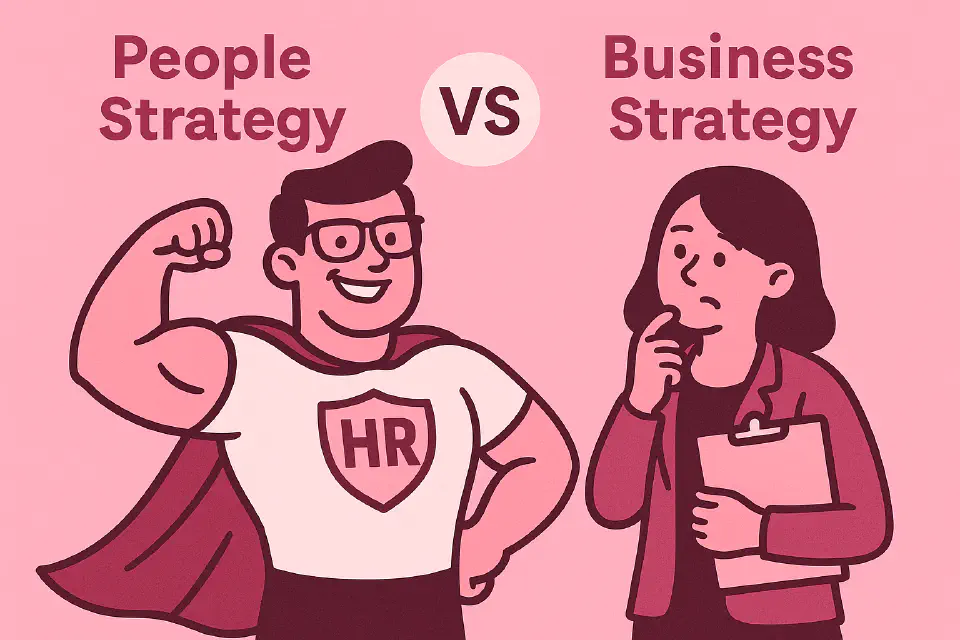
People Strategy vs Business Strategy
Your business strategy defines the ‘what.’ Your people strategy defines the ‘how.’ But they don’t always align on their own.
For years, HR was told to “align with the business.” But what does that actually mean?
The phrase suggests that business strategy and people strategy are separate—and that HR must fit into an already defined path. In reality, HR should be co-creating strategy, not merely supporting it.
This page explores the differences and connections between business and people strategies, and how HR can lead the conversation instead of trailing behind.
What Is a Business Strategy?
Business strategy defines the organization’s long-term direction. It answers fundamental questions:
- What markets will we compete in?
- What value will we deliver?
- How will we position ourselves?
- What capabilities will we invest in?
It’s usually developed by senior leadership and owned by the CEO. It affects every part of the company—including HR.
Business strategy shapes the required operating model, structures, investment priorities, and performance expectations.
What Is a People Strategy?
People strategy is HR’s response to business needs—and a strategic lever in its own right.
It defines how the organization attracts, develops, retains, and organizes its people to deliver the business strategy.
But more than that, people strategy can shape how the business grows:
- Do we build capabilities internally or buy them?
- Do we centralize or empower local teams?
- Do we focus on engagement or efficiency?
- Do we value stability or agility?
In this sense, people strategy isn’t just implementation—it’s direction-setting.
Areas of Overlap and Tension
Despite being interdependent, people strategy and business strategy can diverge in surprising ways:
| Area | Business Strategy Focus | People Strategy Focus |
|---|---|---|
| Speed | Market agility, go-to-market speed | Workforce readiness, hiring cycles |
| Innovation | Product or tech differentiation | Culture of learning, psychological safety |
| Cost | Margin control, outsourcing | Talent investment, internal development |
| Structure | Centralization vs decentralization | Empowerment, span of control, autonomy |
| Risk | Compliance, brand reputation | Ethics, trust, DEI, workforce resilience |
Understanding where trade-offs lie is crucial. A business strategy based on rapid expansion might conflict with an HR strategy focused on sustainability or long-term talent development.
How to Align People Strategy with Business Strategy
Here’s how HR can close the gap—and contribute proactively:
1. Join the Strategy Table
HR leaders should participate in the formation of business strategy, not just receive it. Understanding the drivers behind business choices allows HR to anticipate talent implications.
2. Translate Strategic Goals into Talent Plans
Every strategic objective—expansion, transformation, digitization—requires human capabilities. HR must translate these into workforce plans, learning paths, and culture shifts.
Example: If the strategy is digital innovation, HR needs to map current skill gaps, revamp the EVP to attract tech talent, and create agile performance systems.
3. Challenge Misalignment
HR must challenge business strategies that ignore people risks. For example, a plan to outsource critical functions may weaken long-term capabilities or damage culture.
4. Create Feedback Loops
HR can use data from engagement surveys, exit interviews, and workforce analytics to assess whether the people strategy actually supports business performance—and make course corrections.
Evolving the Conversation
The most mature organizations no longer think in terms of “HR strategy” vs “business strategy.” They have an integrated strategy—where people, technology, operations, and finance are seen as interlinked levers.
This requires a mindset shift:
- From serving business to co-leading it.
- From enabling decisions to shaping them.
- From reactive alignment to strategic integration.
Conclusion
Business strategy and people strategy should not exist in separate silos. When aligned, they power each other.
HR’s role is not to follow—but to lead where talent matters most. That means building a people strategy that’s not just in line with the business strategy—but inseparable from it.